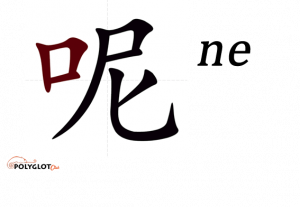Difference between revisions of "Language/Mandarin-chinese/Grammar/呢-ne"
< Language | Mandarin-chinese | Grammar
Jump to navigation
Jump to search
| Line 7: | Line 7: | ||
==Examples== | ==Examples== | ||
*<span class="notranslate">我 是 法国人,你 <code>呢</code> ? ‹ Wǒ shì Fǎguórén, nǐ ne? ›</span> | *<span class="notranslate">我 是 法國人,你 <code>呢</code>?/我 是 法国人,你 <code>呢</code> ? ‹ Wǒ shì Fǎguórén, nǐ ne? ›</span> | ||
<blockquote>I am French, and you?</blockquote> | <blockquote>I am French, and you?</blockquote> | ||
*<span class="notranslate">他 叫 大卫,她 <code>呢</code> ? ‹ Tā jiào Dàwèi, tā ne? ›</span> | *<span class="notranslate">他 叫 大衛,她 呢?/他 叫 大卫,她 <code>呢</code> ? ‹ Tā jiào Dàwèi, tā ne? ›</span> | ||
<blockquote>His name is David, what about her?</blockquote> | <blockquote>His name is David, what about her?</blockquote> | ||
Revision as of 13:16, 18 November 2018
Using the particle 呢 <ne> allows to briefly ask a question about a subject that has just been discussed.
Structure
Sentence, + Subject + 呢?
Examples
- 我 是 法國人,你
呢?/我 是 法国人,你呢? ‹ Wǒ shì Fǎguórén, nǐ ne? ›
I am French, and you?
- 他 叫 大衛,她 呢?/他 叫 大卫,她
呢? ‹ Tā jiào Dàwèi, tā ne? ›
His name is David, what about her?
